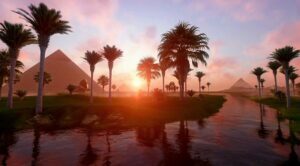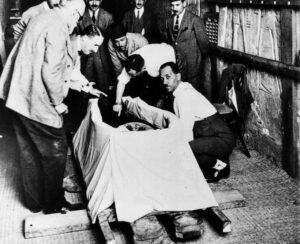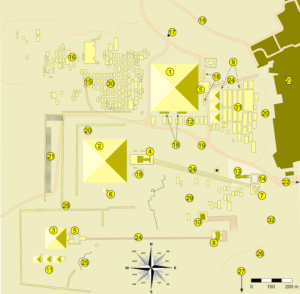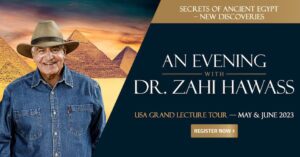
Dr. Zahi Hawass is known the world over as Egypt’s ‘celebrity’ archaeologist, and for good reason. Few archaeologists in the world can equal him in terms of major archaeological discoveries. Here, writer Richard Marranca was afforded a rare opportunity to ask a few questions about Hawass’s latest published popular works and discoveries………..
___________________________________
RM (Richard Marranca): You and your team studied King Tutankhamun’s mummy with a CT scan. Can you tell us about what you learned? What are some mysteries you wish were solved?
ZH (Zahi Hawass): We know Tutankhamun was not murdered. The hole in his skull was made by the embalmers for removing his brain tissue. Other damage to the mummy was done by Carter in an effort to remove the golden mask and other treasures. We did find out, however, that Tutankhamun had a flat foot. The blood would not reach his toes and he had to walk with a cane. He also had an injury to his leg two days before he died. It seems then that he died in some kind of accident. We are studying the mummy to see if there was any infection around the leg injury which might have killed him.
_______________________________

Howard Carter, with magnifying glass, leaning over mummy of King Tutankhamen as the first incision was made in the mummy wrappings. Note: the Library of Congress dates this photo to February 1926, but according to Carter’s journals, he exposed the mummy on 28 October 1925. Public Domain, Wikimedia Commons
_______________________________
RM: In an anthology, Discovery: Unearthing the New Treasures of Archaeology, you mentioned that finding the cemetery at Giza proves that the “pyramid builders were free Egyptians and not slaves.” Also, you mentioned that there were just “10,000 workmen at any one time.” Can you tell us about this?
ZH: The discovery proved that these workers had Egyptian names and were workers, not slaves. They were not foreigners forced to work. If they had been slaves, they would never have been buried at Giza. They were given tombs for eternity like the kings and queens whose pyramids they helped build. The lower cemetery was for the workers who moved the stones while the upper cemetery was for the technicians and more skilled workers. Important families in the country would send workmen to work on the pyramids. To the east of the cemetery, we also found a bakery and an area for making fish. These workers were well fed with areas for sleeping. There were villages for the timber workmen and for the artisans. This was a large project with many people working on it. [More about this: https://www.guardians.net/hawass/buildtomb.htm]
________________________________

Detail: Tombs of the builders. Ahmed Yousry Mahfouz, Creative Commons Attribution-Share Alike 4.0 International, Wikimedia Commons
________________________________

Map of the Giza pyramid complex, including the buyilders’ cemeteries (30 and 31), and the builders’ quarters (21).MesserWoland, GNU Free Documentation License. Wikimedia Commons
________________________________
________________________________
RM: In the second essay in Discovery, you mentioned a few tantalizing mysteries about the Great Pyramid at Giza. Can you tell us about that and also the use of robots to explore nooks and crannies? Also, you mentioned Tutankhamun’s mother’s tomb in the Valley of the kings. Is it hers?
ZH: We were looking at small tunnels high inside the pyramid. We hired a robot from Germany to explore these tunnels. It went into a tunnel and at 60 m it was stopped by a door with two copper handles. We then did a live show with Nat Geo where we put a hole in the door to see what was behind it and found a second door. We are still working to find what is going on in unexplored areas of the pyramid. We have different teams using multiple different technologies to look for voids and possible unknown chambers.
As to the mother of Tutankhamun, we found through DNA analysis that she is the younger female mummy from KV35, however we still do not know her name. We know that she was a daughter of Amenhotep III and Queen Tiye, meaning that Akhenaten married his own sister. Her mummy was moved to the cache in KV35 at a later date, so we are still looking for her tomb.
RM: Can you explain the aspects of a mortuary temple and tomb that are especially important for the deceased to reach the afterlife – to be reanimated forever?
ZH: The mortuary temple maintains the cult of the king as a god. This is where offerings to the cult would be given, which renews the cult of the king. Without the temple, there would not be regular offerings. Originally, these temples were directly connected to the pyramid of the king. When kings began to be buried in the Valley of the Kings rather than in pyramids, the temples were located on the West Bank of Luxor near the Valley, although usually not directly connected.
The tomb is the king’s eternal house. This is where everything was placed for him that he needed to bring to the afterlife, including copies of the spells which he will need to successfully journey to that afterlife.
____________________________

Hatshepsut’s mortuary temple, among the most famous mortuary temples of ancient Egypt. Onceinawhile, Creative Commons Attribution-Share Alike 4.0 International, Wikimedia Commons
____________________________
RM: You write, “Although death was not seen as an end, it was considered a dangerous journey fraught with threatening forces.” Did most people believe they would surmount the obstacles and be reanimated?
ZH: Yes. We can see through temples and tombs that everyone believed in the afterlife – kings, queens, nobles, and common people. They did, however, like to have some extra insurance that they would get there. This is why they built tombs with everything they would need and used spells such as the Book of the Dead to guide their way.
RM: Your book, Valley of the Golden Mummies,” is about the great discoveries at Bahariya Oasis. You show “a wide range of monuments, tombs, and temples dating from as early as the Eighteenth Dynasty through the Greco-Roman and Coptic Periods.” Can you tell us about this?
ZH: This was a very important discovery. We found over 200 mummies with gold, including two mummies of children beautifully mummified. These mummies were all put in a nearby museum. We also found many artifacts such as stelae, necklaces, and especially cups for wine. The reason these burials were so rich is that the people in Bahariya made and sold wine. They clearly did good business judging by the items in their tombs. We did not excavate the entire area, however. We intentionally left tombs for future generations to excavate, perhaps with even better methods than we have today.
RM: What are the types of mummies that were found? What about “The Bride Mummy” that you wrote about?
ZH: We found a mummy covered with gold. The cartonnage was prepared with religious scenes. She appeared to be a bride prepared for her husband…. Perhaps she died before the wedding? We can’t know for sure. We found so many mummies that there was a great variety. Not all of them had gold, including a mummy I nicknamed “Mr. X”. We x-rayed Mr. X and found that he had died at age 30.
RM: What’s it like going into a tomb for the first time in thousands of years?
ZH: It is always an adventure to go into a tomb. Recently, we found a shaft 20 m under the ground. We entered and found a sealed door. Inside was a sealed sarcophagus, 4300 years old. When we raised the lid, we found a mummy of a woman covered in gold. It is always a thrill to find something that has been buried under the sand for thousands of years.
RM: Did you ever get tricked by a labyrinth or false door?
ZH: We aren’t really “tricked” but we have excavated tombs or shafts that turned out to be unfinished or unused, like the tunnel in the tomb of Seti I. That was a dead end likely because it was unfinished. The king died and they had to quickly make new plans.
RM: In Tut: The Mystery of the Boy King, you mentioned the great experience of knowing Sheik Ali. Can you tell us about him and his famous family?
ZH: Sheikh Ali’s family knew the Valley very well. The Abd el-Rassul family had a reputation for stealing antiquities. They found the cachette of royal mummies in the 1870s. Sheikh Ali was the last member of this family. He owned a hotel, Hotel Marsam, on the West Bank. I met him when he was 72 and I was 22. At that time, he told me about the secret tunnel in the tomb of Seti I, asking me to excavate it if I became a great archaeologist. I later excavated this tunnel and found that it led to a dead end, but at least we had solved the mystery.
RM: Your description of the mystery and silence in the Valley of the Kings at night was beautiful. Can you share that with us?
ZH: When I was young, the first time I went to the Valley of the Kings, I went at night. I climbed the mountain until I reached the peak so that I could look over the Valley. It was a beautiful experience and to this day one of the best experiences of my life.
RM: What’s your latest project?
ZH: Currently, I have several projects. We are excavating at Saqqara, finding Old Kingdom tombs near the pyramid of Teti and at Gisr el-Mudir. I am using DNA analysis to search for the mummies of Nefertiti and Ankhesenamun of the 18th dynasty, along with excavating in the Valley of the Kings looking for their tombs. I am also heading a project which is doing conservation on the tomb of Ramses II. Finally, I am still excavating the Golden City, which we found last year in Luxor.
Cover Image, Top Left: Photo by Placidplace, Pixabay
Advertisement

Don’t miss out on this unforgettable evening as Dr. Hawass reveals the most closely guarded secrets of ancient Egypt and presents his groundbreaking new discoveries and latest research live on stage. As the man behind all major discoveries in Egypt over the last few decades and director of several ongoing archaeological projects, Dr. Hawass may yet surprise you with unexpected revelations that will make news across the world.
____________________________




